Lighting 101: Understanding the Basics and Choosing the Right Fixtures for Every Room

Lighting plays a powerful, but often underrated, role in your home’s design. The right lighting doesn’t just illuminate a space; it sets the mood, enhances functionality, and highlights your home’s best features.
Whether you’re selecting fixtures for your brand-new home or refreshing your current space, understanding the basics of lighting can help you make smarter, more stylish choices.
In this guide, we’ll walk through the main types of lighting and offer tips on how to choose the right fixtures for each room in your home. From statement-making chandeliers to practical under-cabinet lights, you’ll learn how to layer lighting for both beauty and function.
The Types of Lighting You Need to Know
Lighting has a direct effect on our mood: bright lights make us feel energized and more productive, while dim lights help us relax and feel calm. A well-designed room should have flexible lighting to meet your needs throughout the day.
So, how do you properly light a room? Since no single light fixture can stand alone, the key is to layer your lighting to accomplish different goals with three basic types of lighting: ambient, task, and accent.
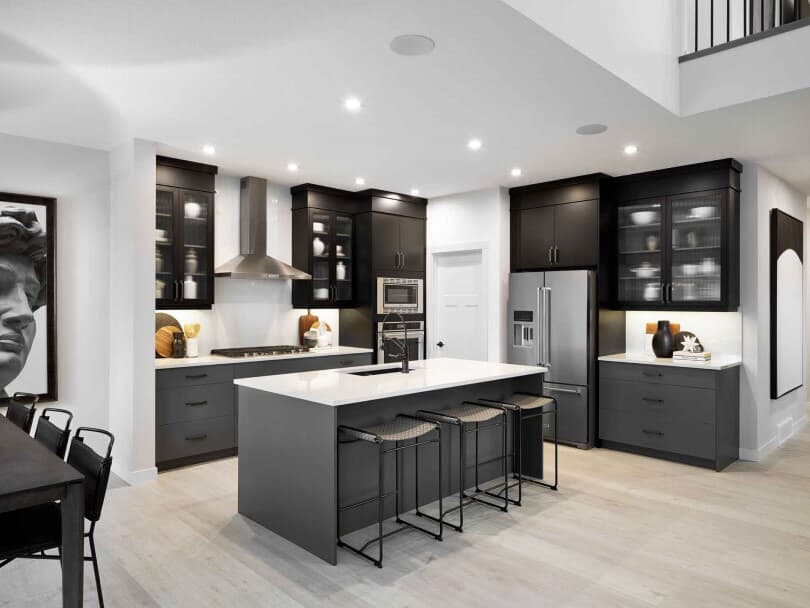
Savona 28 Floor Plan, Front Garage Conventional Collection, Livingston Community, Calgary, Alberta
Ambient Lighting
Ambient lighting, or general lighting, provides overall illumination to a room. It ensures that a space is evenly and adequately lit, allowing people to move around safely and perform everyday tasks.
Common ambient light fixtures include recessed lights or ceiling fans. They’re not always the most glamorous, but they’re necessary to provide comfortable, balanced light and allow you to perform daily tasks.
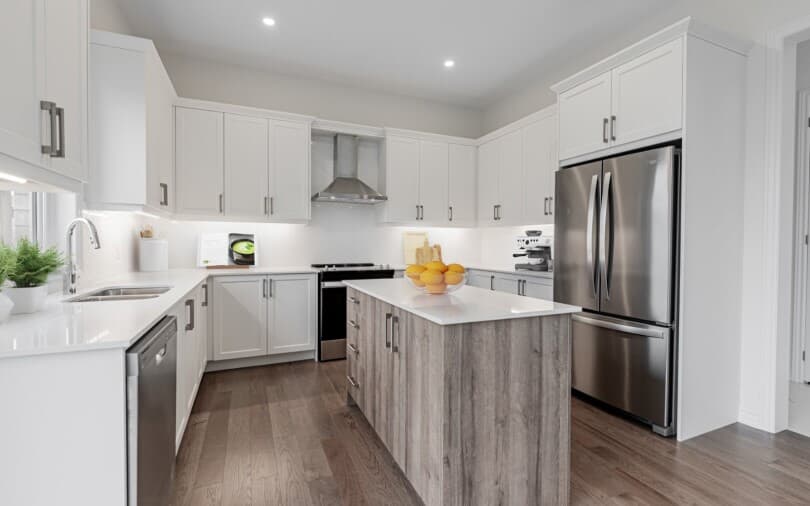
Strathmore Floor Plan, 60' Detached Collection, Heartland Community, Baxter, Ontario
Task Lighting
As the name suggests, task lighting is a designated light source that provides illumination for specific activities or tasks. It’s a must-have in areas where you work, cook, read, write, etc. When you think about task lighting, picture the lamp on your nightstand or the under-cabinet lighting in your kitchen.
Task lighting helps fill the gaps where ambient lighting doesn’t reach and allows you to complete more detailed work, like chopping vegetables or applying makeup. This is why a layered lighting strategy is important in every space.
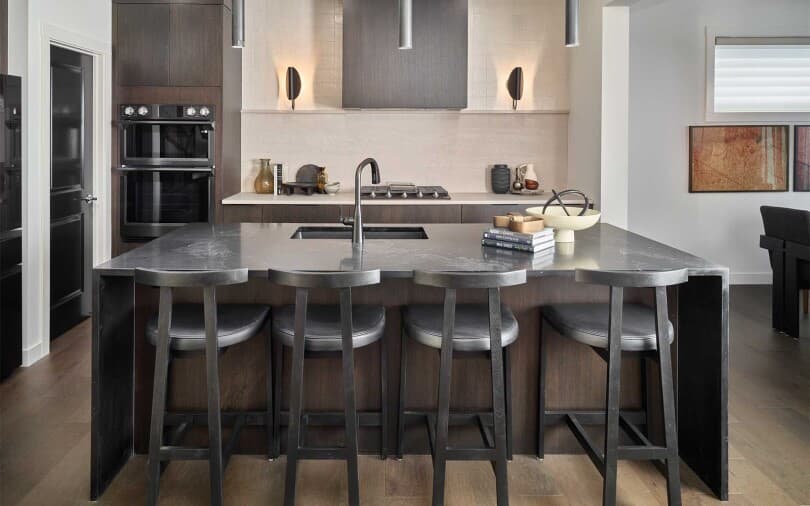
Columbia 26 Floor Plan, Front Garage Conventional Collection, Livingston Community, Calgary, Alberta
Accent Lighting
This final layer in your lighting scheme is commonly called “highlighting,” as it draws attention to a particular area or item, such as artwork, sculpture, plants, or architectural details. It’s a great way to create depth and visual interest by highlighting a focal point.
When all three layers work together, you can easily shift the mood of your space. Turn on all the lights for a vibrant, functional atmosphere or dim the ambient lighting and let accent lights shine for a cozy, intimate vibe. Layering gives you the flexibility to adapt your lighting to the moment—whether it’s prepping dinner, hosting friends, or winding down with a good book.
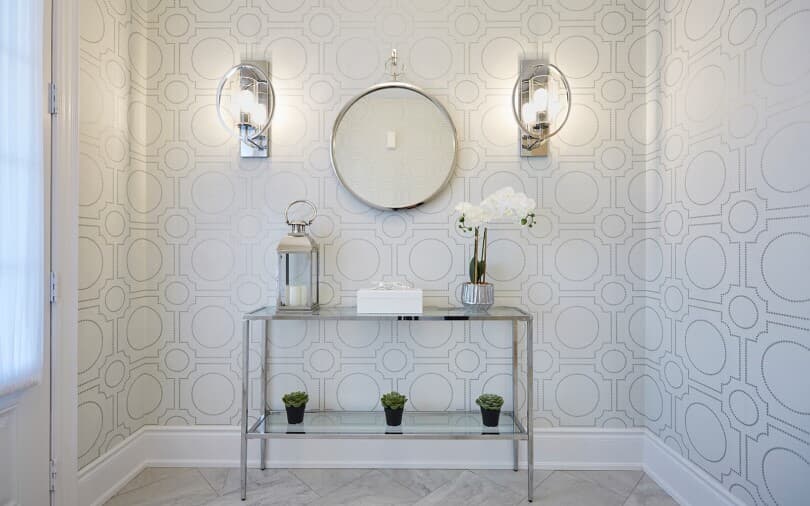
Braydon Floor Plan, 50' Detached Collection, Heartland Community, Baxter, Ontario
Optional: Decorative Lighting
While not essential for function, decorative lighting makes a statement and brings personality to a space. It often overlaps with the other types of lighting, but its primary role is style. Think of decorative lighting as the jewelry of your home— sometimes functional, always eye-catching, and a perfect way to reflect your design taste. Decorative lighting can be things like chandeliers, sculptural pendant lights, artful sconces, or unique statement pieces that serve as focal points.
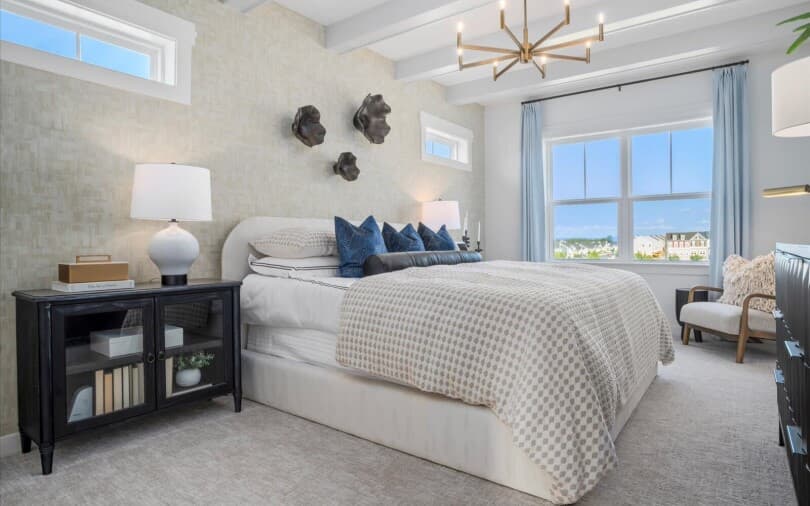
Skyline Floor Plan, Townhome Collection, Snowden Bridge Community, Stephenson, Virginia
How to Choose the Right Light Fixture
Once you understand the different types of lighting, the next step is choosing the right fixtures. When choosing light fixtures, aim to strike a balance between ambiance, functionality, and a style that complements your home’s overall design.
Here are a few key factors to consider when making your decision:
1. Size and scale
When the size of your light fixture doesn’t match the scale of the room, it’s noticeable. You want to ensure the fixture’s size is proportionate to the space. A small fixture in a large space may look out of place, while an oversized fixture can overwhelm a smaller area.
You’ll also want to consider the visual weight of the fixture. If it’s light and airy, you can size up, but a dark and massive fixture may be better scaled down.
2. Cost
Determine how much you’re comfortable spending on a light fixture, and stick to your budget. The price of light fixtures can vary considerably, and you don’t want to fall in love with one that blows your budget. Take the time to shop around to find a fixture that you love and that is wallet-friendly.
3. Purpose & functionality
Think about how you use the space. A fixture that works beautifully in a bedroom might fall short in a kitchen or home office. Are you looking for soft lighting for evening reading? Small nightstand lamps might be the perfect solution. Do you want a dramatic piece over your dining table? A statement-making chandelier may be the way to go.
4. Flexibility
Many spaces in our homes serve multiple functions, and your lighting should be adaptable. Having a light fixture that can support dimmable bulbs is an excellent solution for meeting your household's needs.
The fixture over your dining table should be bright enough for the kids working on homework, but can transition to a romantic dinner at home. One of the benefits of purchasing a new construction home is the ability to plan for different light types and your overall lighting layout.
5. Light bulb size & style
It might not be top of mind when choosing a light fixture, but you need to consider the bulbs that go with your fixture. A fixture that can only hold small candle bulbs may not be the best fit for lighting a large dining space. The pendant lights you’re eyeing may look better with globe bulbs than Edison bulbs. If you have your heart set on a particular style, ensure your light fixture can support complementary light bulbs for a cohesive look.
6. Overall aesthetic
Light fixtures can be a design element all on their own and enhance the overall aesthetics of a space. There’s a wide variety of styles, shapes, and materials, allowing you to find one that complements your décor, or you can choose something with more contrast and flair. Your light fixture’s style ultimately comes down to personal taste and the room in which it’ll be placed.
7. Maintenance
Remember what you will need to do to clean your light fixture and change the bulbs. Do you need to disassemble the fixture to have access to the bulbs? Will the fixture be placed in a high or tricky-to-reach location? If the fixture will be hung up high, it’s wise to use long-lasting LED bulbs and find a fixture design that makes changing bulbs and cleaning easier from a ladder.
Room-by-Room Lighting Tips
Every room in your home serves a different function, and your lighting choices should reflect that. Here’s a room-by-room guide to help you pick the right fixtures and lighting layers for each space:
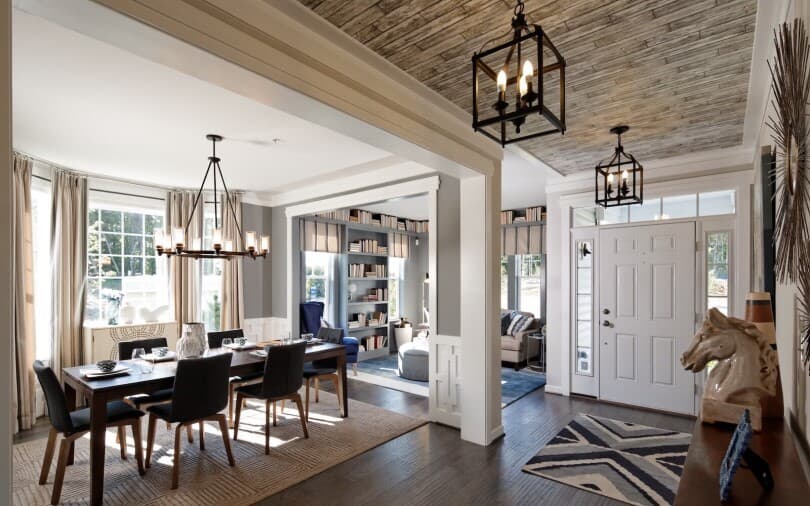
Summerfield Floor Plan, Single Family Homes Collection, Swan Point Community, Issue, Maryland
Entryway
Your entry sets the tone for the rest of your home, so the goal is to make it feel warm and welcoming.
Fixture Ideas: A statement chandelier or pendant light for high ceilings, a flush or semi-flush mount for smaller spaces.
Layering Tip: Add a wall sconce or table lamp on a console for soft, inviting accent lighting.
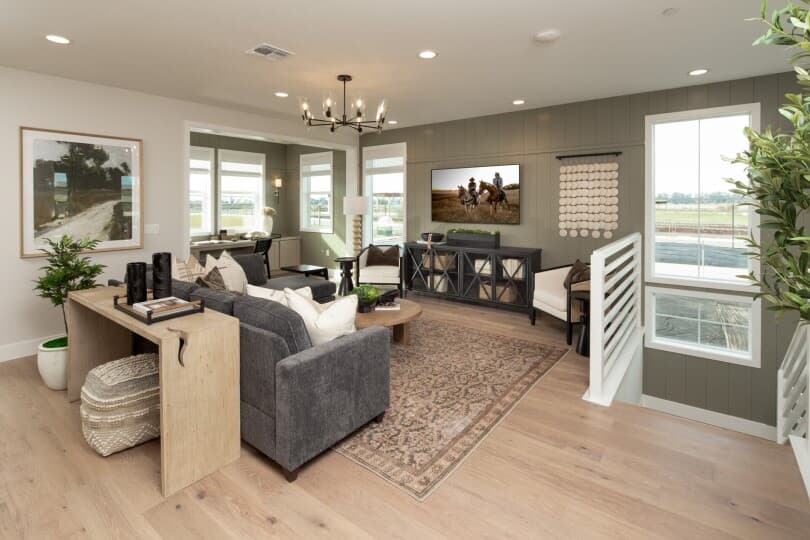
Residence 2 Floor Plan, Foundry Neighborhood, Napa RiverSound Community, Napa, California
Living Room
The living room is your space to relax, entertain, and gather, so lighting should be flexible and layered.
Fixture Ideas: Ceiling fan with integrated light, recessed lighting, or a central semi-flush mount.
Layering Tip: Incorporate floor lamps for cozy ambiance, plus sconces or picture lights for added character.
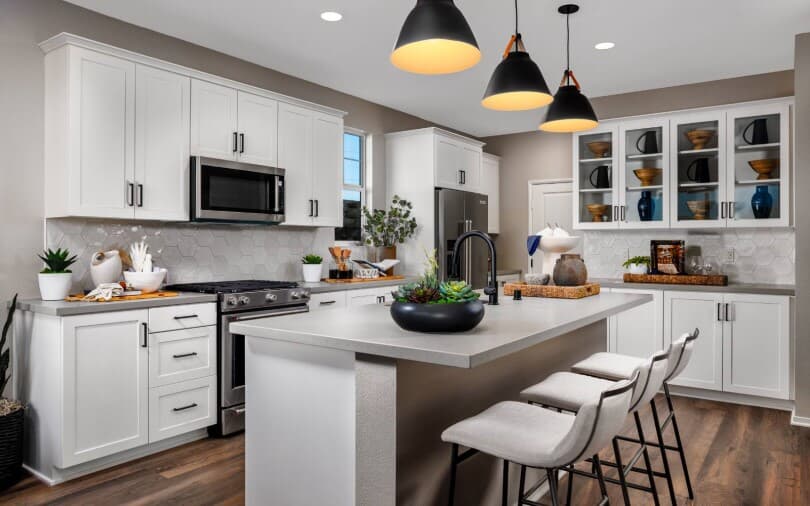
Residence 3 Floor Plan, Dwell Collection, New Haven Community, Ontario, California
Kitchen
Arguably the hardest-working room in the house, your kitchen needs functional and bright lighting.
Fixture Ideas: Pendant lights over the island, recessed lighting for general illumination, and under-cabinet lighting for tasks.
Layering Tip: Consider dimmers for flexibility—you’ll want bright light for cooking and softer lighting for late-night snacks.
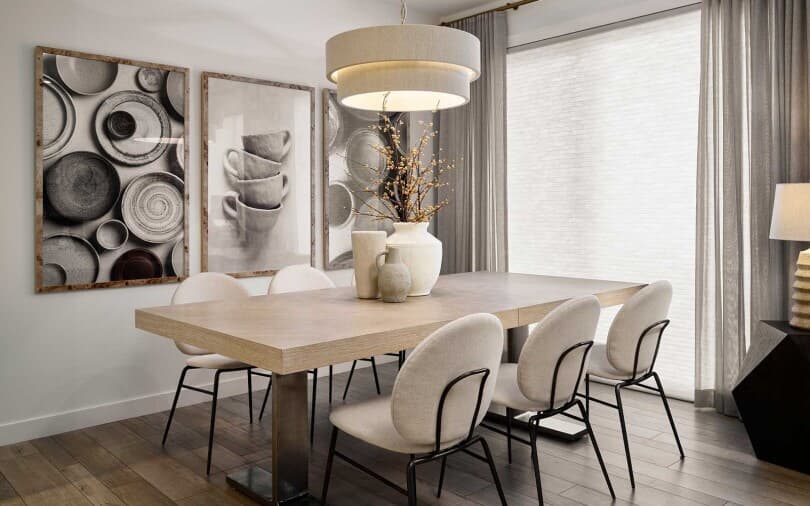
Purcell 24 Floor Plan, Front Garage Collection, Creekstone Community, Calgary, Alberta
Dining Room
Lighting here should feel intentional—functional for meals, but also decorative enough to elevate the space.
Fixture Ideas: A chandelier or linear pendant centered above the table is a classic choice.
Layering Tip: Add a dimmer switch for mood control and wall sconces or buffet lamps for ambient accents.

Glendale Floor Plan, Traditional Collection, New Seaton Community, Pickering, Ontario
Bathroom
Proper lighting is key, especially around mirrors where you get ready for the day.
Fixture Ideas: Vanity lights on either side of the mirror (or a horizontal bar above), paired with ceiling-mounted or recessed lighting.
Layering Tip: Use bright, flattering light in front of the face—not just from above—to reduce shadows.
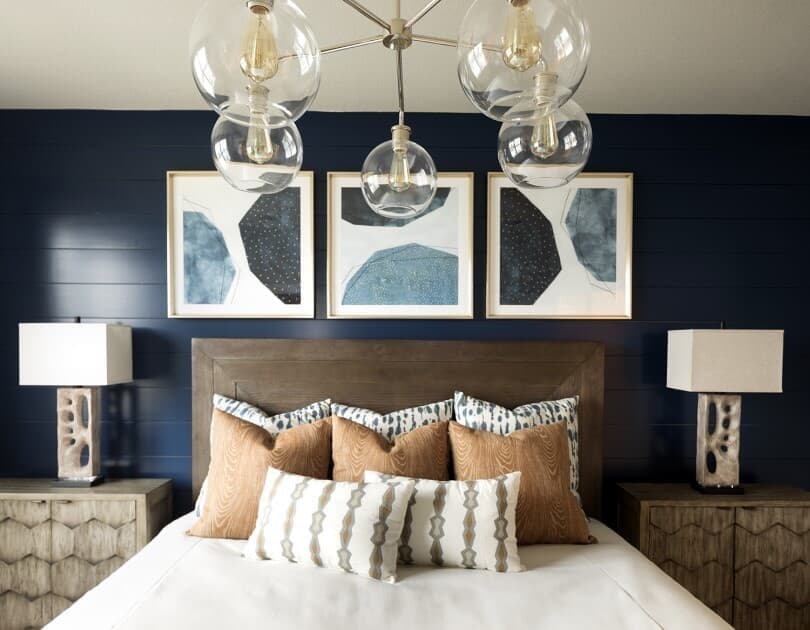
Dickinson Floor Plan, Urban Courtyard Homes Collection, Easton Park Community, Austin, Texas
Bedroom
A bedroom should be serene and restful, with options for both ambient and task lighting.
Fixture Ideas: Flush or semi-flush ceiling lights for general lighting, bedside lamps or sconces for reading.
Layering Tip: Add a dimmer to your main light and consider soft, warm bulbs to create a calming environment.
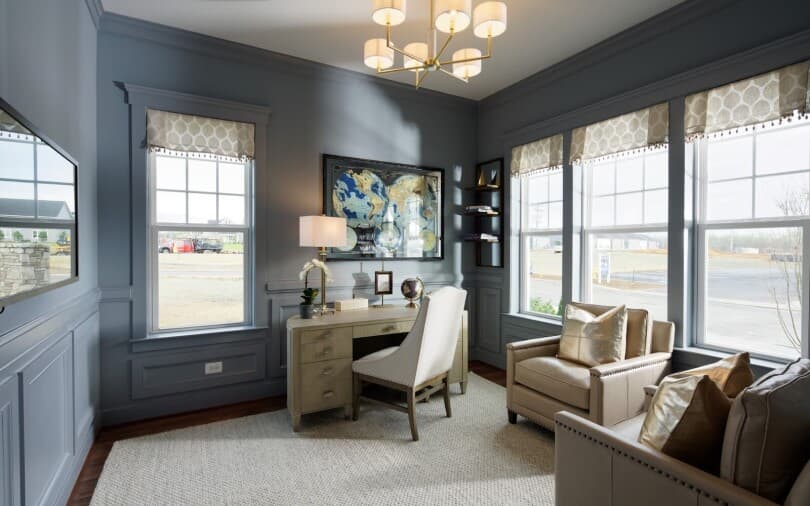
Home Office
Good lighting helps you stay focused and productive, especially if you’re working from home.
Fixture Ideas: A combination of overhead lighting and a desk lamp with adjustable brightness.
Layering Tip: Use cooler light temperatures (4000K–5000K) to promote alertness and reduce eye strain.
A well-lit home isn’t just about function—it’s about creating moments, enhancing your décor, and shaping the way each space feels. Thoughtful, room-specific lighting can truly transform your everyday experience.

Cambridge Floor Plan, Traditional Homes Collection, Easton Park Community, Austin, Texas
Smart Lighting Enhancements
Once you’ve nailed down your lighting layers and fixtures, it’s time to take things up a notch. Smart lighting technology can make your home more energy-efficient, more convenient, and even more customizable.
Dimmer Switches
Dimmers give you instant control over brightness, helping you set the mood and save energy at the same time. They’re especially helpful in living rooms, dining areas, and bedrooms, where lighting needs may shift throughout the day.
Smart Bulbs
With smart bulbs, you can control your lights from your phone, a voice assistant, or even on a schedule. Many allow you to:
- Adjust brightness and color temperature
- Change colors for fun or seasonal ambiance
- Set timers or automate based on your routine
Popular brands like Philips Hue, LIFX, and Sengled are compatible with platforms like Alexa, Google Home, and Apple HomeKit.
Motion Sensors and Automation
Add convenience and efficiency with motion-activated lights in areas like:
- Hallways and staircases
- Closets or pantries
- Outdoor spaces and garages
You can also set up scenes or routines—like “Good Morning” or “Movie Night”—that adjust multiple lights at once with a single command or tap.
Smart Switches and Plugs
If you’d rather keep your existing fixtures but still want smart control, smart switches or plugs are a great solution. They let you control traditional lights through apps or voice commands without changing the bulbs.
Pro Tip: Start small with one or two smart upgrades and expand as you find what works best for your lifestyle.
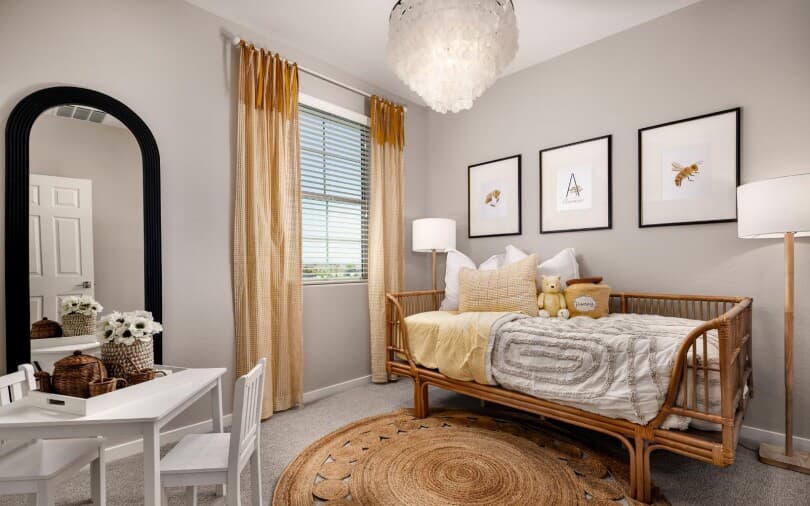
Ponderosa Floor Plan, Laurel Collection, Blossom Rock Community, Apache Junction, Arizona
Thoughtful lighting is more than a finishing touch—it’s the invisible thread that ties each room together, shaping how your home looks, feels, and functions every single day. By layering ambient, task, and accent light, choosing fixtures that fit both form and scale, tailoring solutions to each space, and sprinkling in a few smart upgrades, you create an adaptable backdrop that works just as hard as you do.
Be sure to follow the Brookfield Residential blog for more design advice, homebuying insights, mortgage tips, and more. Explore where we build and connect with our sales team when you’re ready to learn more. We’ll be expecting you!
